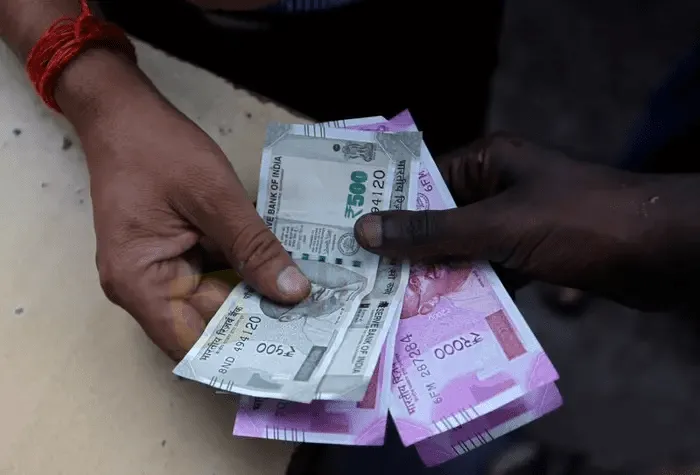简体中文
繁體中文
English
Pусский
日本語
ภาษาไทย
Tiếng Việt
Bahasa Indonesia
Español
हिन्दी
Filippiiniläinen
Français
Deutsch
Português
Türkçe
한국어
العربية
Indian rupee set to trade near historic low in coming three months – Reuters Poll
Abstract: India’s rupee will trade near its historic low in the coming three months, despite a recent recovery, based on a widening trade deficit and global flows into safe-haven U.S. dollars, a Reuters poll of foreign exchange strategists found.

After a month of trading near a nadir of 80.065 per dollar, the currency strengthened to a one-month high of 78.490 on Tuesday, providing relief for the Reserve Bank of India, which has been burning through foreign currency reserves defending 80 per dollar.
But the revival is not likely to last. The median forecast in an Aug. 1-3 Reuters poll of 40 analysts showed it trading back near an all-time low by end-October.
Nearly 50% of analysts, 18 of 40, expected the partially convertible rupee to have reached or breached the 80 per dollar mark in three months, compared with just 30% who said so in a July poll. Most saw it sinking to a new record low.
Asked what would be the rupees lowest point against the dollar over the course of the next three months, 16 analysts who answered an extra question gave a median of 80.50, with a range of 79.75-81.80/$.
Much will depend on what the Reserve Bank of India decides to do with interest rates. In a separate Reuters poll, it was expected to raise the repo rate, currently at 4.90%, by a minimum of 35 basis points on Friday, but economists were split four ways on the size of the move.[RBI/INT]
Sakshi Gupta, an economist from HDFC Bank said the focus is now on whether or not the U.S. Federal Reserve delivers a third consecutive 75 basis point interest rate hike at its September meeting.
“The RBI is not likely to be as aggressive…further depressing the rupee,” she said.
Indias central bank, which only began raising rates in May, is relatively behind in its hiking campaign and is only due to deliver 110 basis points more in total.
Gupta also said the latest U.S.-China tensions added to an already attractive environment for the safe-haven U.S. dollar.
“That suggests the recent rally is short-lived and there is a strong possibility of the rupee breaching the 80 mark,” she said.
But not everyone was convinced the rupee would weaken, as continued bouts of speculation the Fed may deliver fewer rate hikes and the recent slump in commodity prices may restrain the dollar from making further gains.
“The RBI may be required to intervene less to defend the rupee over the coming months than it has so far this year,” noted Shilan Shah, senior India economist at Capital Economics, who argues most of the rise in the dollar is now over and commodity prices will also fall back in coming months.
The latest poll showed the currency was expected to recover to 78.83 per dollar by end-July next year.

Disclaimer:
The views in this article only represent the author's personal views, and do not constitute investment advice on this platform. This platform does not guarantee the accuracy, completeness and timeliness of the information in the article, and will not be liable for any loss caused by the use of or reliance on the information in the article.
Read more

XTB Hack 2025: Major Security Breach Exposes Client Accounts
XTB suffers a major hack in 2025, with hackers draining client accounts and sparking urgent security upgrades. Learn how the breach unfolded and what’s next.

XTB Hack 2025: Major Security Breach Exposes Client Accounts
XTB suffers a major hack in 2025, with hackers draining client accounts and sparking urgent security upgrades. Learn how the breach unfolded and what’s next.

Want to Succeed in Forex? Start with the Right Trading System
If you want to trade currencies and make money in the long run, you need a good forex trading system. Many new traders enter the market without a clear plan. Some rely on luck or tips from others. But trading without a system often leads to losses.

Mumbai Police Nabs Black Paper Dollar Conversion Forex Scam Perpetrators: Check Out the Details
The crime branch of the Mumbai Police has nabbed a racket involved in duping people by claiming to convert black paper into dollars. Check this unique 24.7-lakh scam story.
WikiFX Broker
Latest News
US Government Interest Grows in Victory Metals’ Rare Earths Supply
How Are Trade Policies Affecting the Aluminum Market?
RM71,000 Lost in a Share Scheme That Never Existed
Scammed by a Click: He Lost RM300,000 in a Month
Manual vs. Automated Forex Trading: Which One Should You Choose?
Revealing Factors That Help Determine the Gold Price in India
Why Regulatory Compliance Is the Secret Ingredient to Trustworthy Forex Brokers
Pentagon to become largest shareholder in rare earth miner MP Materials; shares surge 40%
Delta shares jump 12% after airline reinstates 2025 profit outlook as CEO says bookings stabilized
Delta shares jump 13% after airline reinstates 2025 profit outlook as CEO says bookings stabilized
Currency Calculator


